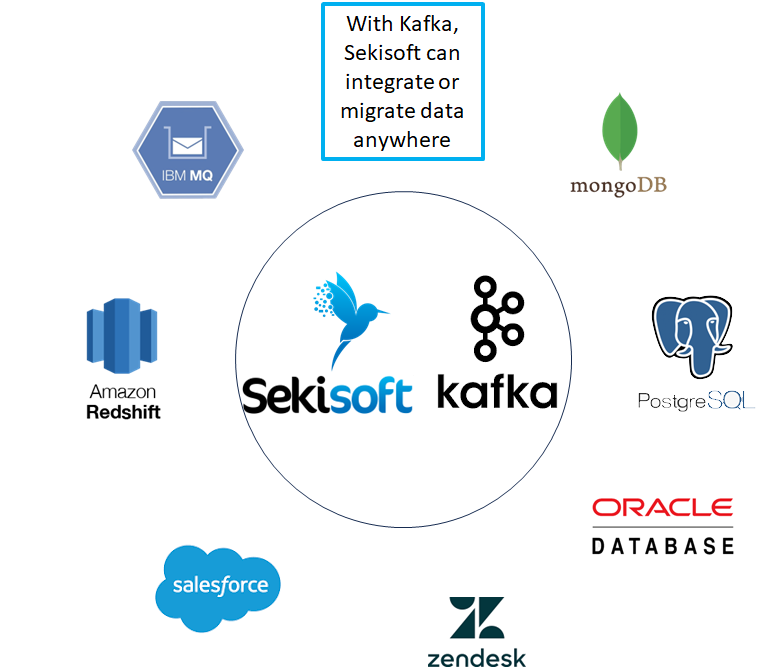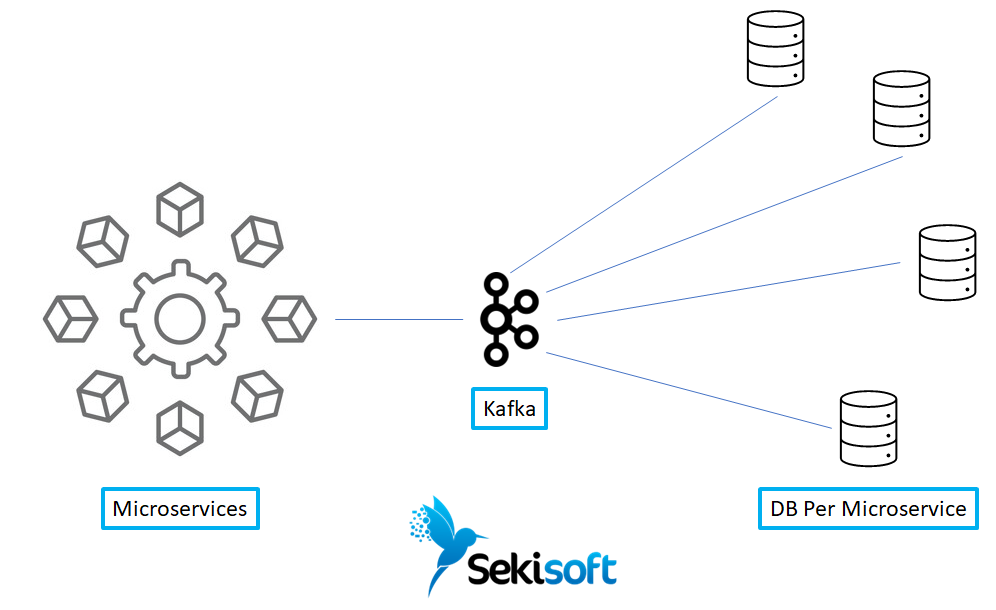Customize and Capitalize
Sekisoft's Architectural Evolution: Integrating Apache Kafka for Superior Performance and Extensibility
Sekisoft represents a paradigm shift in software solutions, embodying a suite of highly efficient
microservices that encapsulate its entire functionality. At the core of this innovative architecture is
Apache Kafka, a cornerstone technology that not only facilitates but also amplifies the effectiveness of
Sekisoft’s offerings. Kafka plays a critical role along with implementing the CQRS and SAGA patterns
within
Sekisoft, ensuring that all data across the platform maintains cohesion and consistency. This is
essential in a landscape where data integrity and accuracy are paramount.
Separates read and write operations for a data store. Improves performance, scalability, and security in complex systems. Adds complexity as the action of updating data (command) is distinct from the action of reading data (query).
A series of local transactions where each transaction updates data within a single service. Maintains data consistency in distributed systems through compensating transactions if a transaction fails. Useful in microservices architectures.
Sekisoft's integration with Apache Kafka is a pivotal element in its architecture, transforming it into a highly capable and dynamic platform. Let's delve into the technical details to understand how Kafka enhances the Sekisoft platform, particularly focusing on its role in implementing CQRS and SAGA patterns, as well as facilitating data migrations and system integrations.
Apache Kafka in Sekisoft's Architecture
1. Core Functionality:
Event Streaming: Kafka serves as an event streaming platform within
Sekisoft. It captures data in
real-time from various sources and makes it available to multiple consumers. This forms the backbone of
Sekisoft's event-driven architecture.
Distributed System: Kafka's distributed nature allows Sekisoft to
scale horizontally, handling large
volumes of data across multiple servers. This is crucial for a microservices architecture, ensuring high
availability and fault tolerance.
2. Implementing CQRS and SAGA Patterns:
CQRS (Command Query Responsibility Segregation): In Sekisoft, Kafka
aids in separating the command side
(actions that modify data) from the query side (actions that read data). Kafka topics can be used to
store events resulting from commands. These events are then processed by different microservices, which
update their own read models, ensuring that the system can handle high read and write loads efficiently.
SAGA Pattern: Kafka facilitates the SAGA pattern in distributed
transactions across multiple
microservices. Each local transaction publishes an event to a Kafka topic, which triggers the next local
transaction in the SAGA. If a transaction fails, compensating transactions are triggered from the events
in Kafka topics, maintaining data consistency across microservices.
3. Data Migrations and Integrations:
Data Migration: Kafka provides a robust mechanism for data
migrations within Sekisoft. By streaming data
from one service to another, Kafka ensures minimal downtime and consistent data transfer, which is
essential during database migrations or when upgrading service versions.
External System Integrations: Kafka acts as a centralized hub for
integrating external systems with
Sekisoft. It can consume data from various sources, process it, and then make it available to Sekisoft's
microservices in a uniform format. This is particularly beneficial for integrating legacy systems or
third-party services.

4. Performance and Extensibility:
High Throughput and Low Latency: Kafka's ability to handle
high-throughput data streams with low latency
is crucial for Sekisoft’s performance. It ensures real-time processing of large data volumes, making the
system responsive and efficient.
Future-Proofing: Kafka’s scalability and the flexibility of its
topic-based architecture make Sekisoft
adaptable to future requirements. Whether it's expanding the system with new features or scaling to
accommodate more users, Kafka's architecture supports this growth seamlessly.
The integration of Apache Kafka into the Sekisoft platform revolutionizes its capabilities. By enabling efficient implementation of CQRS and SAGA patterns, Kafka enhances data integrity and system responsiveness. Its role in data migrations and external system integrations ensures that Sekisoft remains a versatile and future-proof solution. The performance benefits brought by Kafka, particularly in high-throughput scenarios, position Sekisoft as a leader in the digital software solution space, capable of meeting the evolving demands of a data-driven world.

The strategic integration of advanced technologies in the Sekisoft platform yields substantial practical benefits. With its architecture rooted in agile and resilient systems, Sekisoft is exceptionally equipped to handle complex, distributed transactions effortlessly. This capability is a cornerstone in ensuring enhanced data integrity and a superior user experience. The seamless flow of information across various Sekisoft modules — such as contacts, tasks, documents, and case management — is a testament to this. The platform's design not only facilitates efficient data management but also ensures that every module operates in harmony, contributing to a streamlined and cohesive operational framework.
| Key Factor | Importance | Benefit |
|---|---|---|
| Agile System Architecture | Essential for adapting to rapid changes and demands in the business environment. | Enables quick adaptation to market shifts, ensuring business competitiveness. |
| Resilience in Distributed Transactions | Critical for handling complex operations across various modules. | Ensures seamless and uninterrupted business processes, even in complex scenarios. |
| Enhanced Data Integrity | Vital for accurate and reliable data management across the platform. | Leads to better decision-making, fostering trust in the system's reliability. |
| Streamlined Information Flow | Facilitates the efficient movement of data between different modules like contacts and tasks. | Enhances operational efficiency, reducing time and effort in information management. |
| Superior User Experience | Directly impacts user engagement and satisfaction with the platform. | Increases user productivity and satisfaction, leading to higher adoption rates. |
| Integration with Key Technologies (e.g., Apache Kafka) | Ensures that the platform remains cutting-edge and versatile. | Enables the handling of large-scale data and complex integrations, expanding capabilities. |
These advancements bring about transformative outcomes for businesses. The agility of Sekisoft allows for rapid adaptation to evolving business needs, ensuring that organizations remain competitive and responsive in a dynamic market. The resilience of the system underpins its reliability, instilling confidence in its capability to manage critical business functions without interruption. Enhanced data integrity leads to more informed decision-making, while the improved user experience fosters higher engagement and productivity among users. Overall, Sekisoft’s sophisticated integration of technologies such as Apache Kafka, combined with its microservices architecture, positions it not just as a software solution, but as a pivotal tool for business growth and success.
The trajectory of Sekisoft’s technology is steering towards an increasingly interconnected future, with
integrations that extend its capabilities far beyond its core functionality. Sekisoft is strategically
positioned to connect with and expand through systems such as QuickBooks for financial management,
RedShift for data warehousing, PostgreSQL for database solutions, and IBM MQ for messaging and
integration. The inclusion of these systems not only broadens the scope of Sekisoft’s applicability but
also amplifies its efficiency and versatility. Integrations with various inventory management systems
are also in the pipeline, promising a more comprehensive solution that spans multiple aspects of
business operations. These advancements are set to revolutionize the user experience by significantly
reducing the friction encountered when transitioning between different systems. The ability to offer a
seamlessly integrated experience is a game-changer in the realm of business software solutions.
The benefits of such integrations are manifold. For starters, connecting Sekisoft with QuickBooks paves
the way for smoother financial transactions and data synchronization, which is vital for accurate
accounting and budgeting. Integration with Amazon RedShift enables the handling of massive volumes of
data, enhancing data analytics and decision-making processes. By incorporating PostgreSQL, Sekisoft
gains a robust and reliable database backend, ideal for complex data management needs. Furthermore, IBM
MQ integration ensures reliable messaging across different systems, facilitating secure and efficient
communication. These integrations not only expand Sekisoft’s functionality but also ensure that it
remains agile, scalable, and capable of adapting to the evolving needs of businesses. As a result, users
benefit from a more holistic software solution that streamlines operations, enhances data accuracy, and
ultimately drives business growth and success.
As a technology enthusiast and entrepreneur deeply involved in the cutting-edge development of Sekisoft, I view the integration of technologies like Apache Kafka not as a final achievement, but as a pivotal step in an ongoing journey of innovation. The incorporation of Kafka into a sophisticated microservices architecture, as exemplified by Sekisoft, represents a significant advancement in how businesses handle complex data interactions and maintain operational efficiency.
This venture into utilizing Kafka, alongside the implementation of CQRS and SAGA patterns within a microservices framework, is just the beginning of exploring their full potential. The implications of these integrations in enhancing system performance, data integrity, and overall business agility are immense and only just being realized. I am keen to engage with those interested in exploring how these technologies can revolutionize their business operations. For a deeper understanding or to discuss potential applications within your own business context, I welcome further discussions and collaborations.